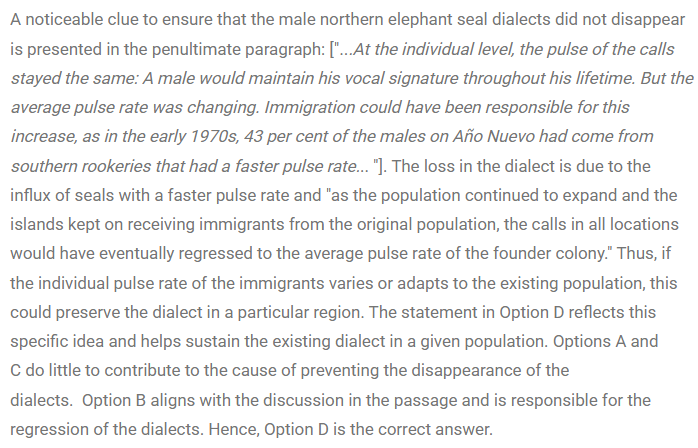CAT RC Questions | CAT RC Based on Natural Science questions
FundaMakers is the Best CAT Online Coaching In India. Now prepare for CAT anytime with FundaMakers. We provide well-ordered syllabus coverage for both offline and online CAT preparation batches. FundaMakers brings to you the power-packed, well-structured CAT previous year question bank with more than 4000+ CAT Past Year questions. In the VARC section, one of the most frequently asked questions is from the topic- Reading Comprehension. Reading Comprehension turns out to be an important part of the VARC section from which over 60-70% of the questions are based on RC in the CAT Exam.
FundaMakers as a team has taken a painstaking step to bring you all the video solutions of the Reading Comprehension asked in the Previous Year CAT exam. CAT question bank offered by FundaMakers is a power-packed topic-wise compilation of the entire CAT previous year questions. Questions from the Reading Comprehension topic are some of the most scoring questions in the VARC section. To maximize your CAT score make use of FundaMakers CAT Question Bank. “Questions from CAT previous years” examination papers have been incorporated. Let’s get started with CAT Past Year Reading Comprehension Questions.
Comprehension
Directions for question: Read the passage carefully and answer the given questions accordingly
In the late 1960s, while studying the northern-elephant-seal population along the coasts of Mexico and California, Burney Le Boeuf and his colleagues couldn’t help but notice that the threat calls of males at some sites sounded different from those of males at other sites. . . . That was the first time dialects were documented in a nonhuman mammal. . . .
All the northern elephant seals that exist today are descendants of the small herd that survived on Isla Guadalupe [after the near extinction of the species in the nineteenth century]. As that tiny population grew, northern elephant seals started to recolonize former breeding locations. It was precisely on the more recently colonized islands where Le Boeuf found that the tempos of the male vocal displays showed stronger differences to the ones from Isla Guadalupe, the founder colony.
In order to test the reliability of these dialects over time, Le Boeuf and other researchers visited Año Nuevo Island in California—the island where males showed the slowest pulse rates in their calls—every winter from 1968 to 1972. “What we found is that the pulse rate increased, but it still remained relatively slow compared to the other colonies we had measured in the past” Le Boeuf told me.
At the individual level, the pulse of the calls stayed the same: A male would maintain his vocal signature throughout his lifetime. But the average pulse rate was changing. Immigration could have been responsible for this increase, as in the early 1970s, 43 percent of the males on Año Nuevo had come from southern rookeries that had a faster pulse rate. This led Le Boeuf and his collaborator, Lewis Petrinovich, to deduce that the dialects were, perhaps, a result of isolation over time, after the breeding sites had been recolonized. For instance, the first settlers of Año Nuevo could have had, by chance, calls with low pulse rates. At other sites, where the scientists found faster pulse rates, the opposite would have happened—seals with faster rates would have happened to arrive first.
As the population continued to expand and the islands kept on receiving immigrants from the original population, the calls in all locations would have eventually regressed to the average pulse rate of the founder colony. In the decades that followed, scientists noticed that the geographical variations reported in 1969 were not obvious anymore. . . . In the early 2010s, while studying northern elephant seals on Año Nuevo Island, [researcher Caroline] Casey noticed, too, that what Le Boeuf had heard decades ago was not what she heard now. . . . By performing more sophisticated statistical analyses on both sets of data, [Casey and Le Boeuf] confirmed that dialects existed back then but had vanished. Yet there are other differences between the males from the late 1960s and their great-great-grandsons: Modern males exhibit more individual diversity, and their calls are more complex. While 50 years ago the drumming pattern was quite simple and the dialects denoted just a change in tempo, Casey explained, the calls recorded today have more complex structures, sometimes featuring doublets or triplets. . . .
CAT/2020.1
Question . 41
Which one of the following conditions, if true, could have ensured that male northern elephant seal dialects did not disappear?
Besides Isla Guadalupe, there was one more founder colony with the same average male call tempo from which male seals migrated to various other colonies.
D : The call tempo of individual immigrant male seals changed to match the average tempo of resident male seals in the host colony.Explanatory Answer
Method of solving this CAT RC Question from RC Based on Natural Science question
Correct Option: D

Hey!
Worried about IIM calls due to your marks in 10th,12th, and Graduation?
Don't worry! Know your chances of getting an IIM Call based on your profile with our:-
Profile Professor: https://fundamakers.com/profile-professor/

5 Must- NOT-Dos during CAT Preparation.
- Do not treat CAT as 'Everything'.
- Do not quit your job for CAT exam preparation.
- Learning till The Eleventh hour instead of doing proper revision.
- Not checking the syllabus thoroughly.
- Piling up multiple books.
Click To Read:- Common mistakes made by CAT aspirants during preparation.
FundaMakers- Best Online and Offline CAT Online Preparation Institute in India
For any CAT Preparation related query, reach out to us at 9598333344.